Flour Power: Interview with Maxine Scheckter, Pastry chef
Wellington pastry chef Maxine Scheckter, Sugar Flour, has just produced her first book. We talk to Maxine about her journey from student to author.
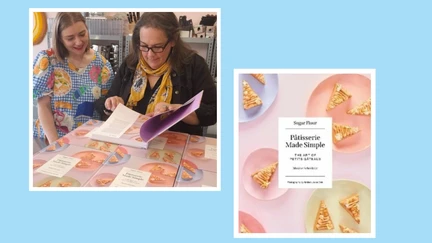
Photos courtesy of Maxine Scheckter, Sugar Flour
If a display of exquisite French patisserie makes you salivate then you are probably familiar with the work of Maxine Scheckter, Sugar Flour. Since returning from France and the UK in 2019, Maxine has produced delicate petits gateaux and taught pastry classes from premises in Kilbirnie, Miramar and more recently, Newlands.
Earlier this year her first book, Pâtisserie made simple : the art of petits gâteaux was released. WCL chats with Maxine about her journey from patisserie student in France to business owner and now author.
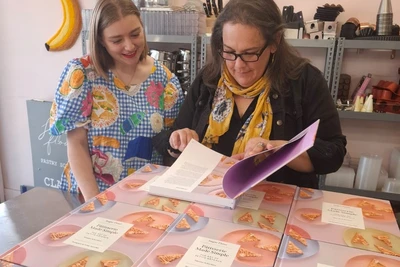
Photo courtesy of Maxine Scheckter, Sugar Flour
WCL: You initially trained at WelTec and then in France. What is it about the craft of patisserie that appeals to you?
MS: I don’t think there’s one particular thing I can say I love about it. I think I just enjoy creating things, doing something with my hands, and there’s something about baking and pastry that’s always just clicked with me.
WCL: What does it take to be a good pastry chef?
MS: For me, it’s the ability to fix things when they go wrong. Things go wrong in the kitchen all the time. So looking at the situation and finding a way to get around that. There’s also a lot of attention to detail and consistency that’s really important as well
WCL: How hard was it to be accepted into French pastry school Ferrandi L’ecole Gastronomie?
MS: I had to write an essay and provide recommendation letters from people I had worked for. The application had to be in by October then one day in December I got an email to say I had been accepted. I screamed so loud my mum thought there was a spider in my room!
The course was specifically aimed at international students and was taught in English or had translators when there were French speaking tutors. There were French lessons taught. I did not do very well in those. I can read French recipes and I can work in a kitchen but I can’t have a conversation about anything of importance.
WCL: Following your study you then completed an internship. Suddenly you are out of the classroom and in the real world of a Parisienne patisserie. Tell us about that experience?
MS: In most countries it’s legal to do work experience and not get paid. In France, in order to stop exploitation especially in the culinary industry, if you want to do an internship you need to be enrolled at a school and you need a contract between yourself, the school and the place you’re working at.
I chose the school I went to because they had the longest internship period, which was six months. When it was time for us to start preparing for our internship they gave us a list of pretty much every place in Paris – restaurant, patisserie, hotel – and we had to give them our top three. They would work with us to find if they were the right choices for us. Luckily for me I got my top pick and it was the perfect place for me.
It was a small team, which was something I wanted because I knew I could learn more. There were four or five full time employees and another 2-3 interns. It was mostly in French. There were two people who didn’t speak any English. Most people were lovely and I picked up on what the phrases meant. It’s good with pastry because its obvious what you need to do. They show you one thing and then you do it over and over again.
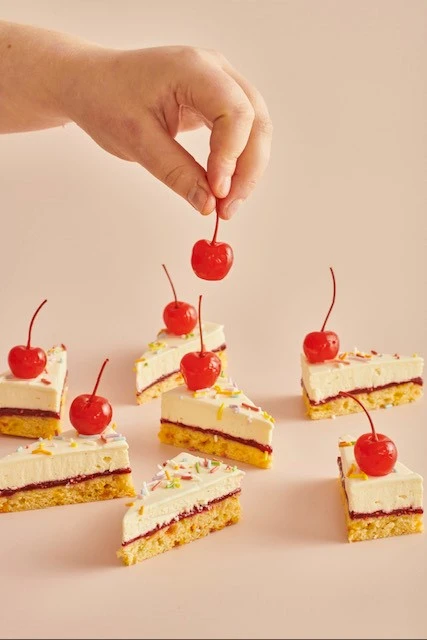
Photo courtesy of Maxine Scheckter, Sugar Flour
WCL: Moving on from Paris you held positions in the UK including working for Heston Blumenfeld. What did you learn about the business working for someone who has been awarded numerous Michelin stars?
MS: I did meet him a few times and he was always really lovely. It was such a structured environment compared to kitchens I had worked in previously. The kitchen I worked in in France was also really structured because there was the patisserie and the hotel across the road with a two Michelin star restaurant. It was all owned by the same chef and we would produce stuff for that.
The way the Fat Duck worked is because it’s a set menu and there’s always the same number of guests you are always making the same quantities of everything. There was a laminated sheet that told you what to do on what day.
It’s because of the style of menu and how incredibly tested every dish is.
There was 17 courses on the menu and you go on a journey of a multi-sensory dining experience. It’s intricately thought out. Nothing should change because it throws everything off balance.
One of the dishes I was in charge of was called Counting Sheep. It was the second to last dessert course you got. On the journey Counting Sheep is that you are going to sleep. You get a plate and its inspired by the smell of talcum powder. They took the components that made up talcum powder and separated them out. There’s tonka bean, coriander, Earl Grey, lychee, bergamot, pistachio – all the flavours were mixed into this dish. The dish was completely white. It tasted amazing. It came with a pillow. The pillow was levitating off the table, spinning while playing a lullaby. On top of the pillow were two little meringues filled with a reduced milk icecream. Everything was white and looked like pillows and made you feel sleepy. It was all so intricately planned.
At that level of restaurant – its such a completely different style you have so much less, yet more, flexibility.
WCL: On your return to New Zealand in 2018 you opened Sugar Flour patisserie and pastry school in Kilbirnie. Was it always your intention to teach others the art of patisserie?
MS: Around that time, in Australia, there was a woman called Kristin Tibballs. She was leading the industry change of teaching patisserie to home cooks. I thought that would be a cool thing to do, and it was another income stream.
A huge amount of being a chef in a kitchen is that you are constantly working your way up. You learn how to do something and then you have to show the next person how to do it. So there’s a huge amount of teaching on the job. I felt pretty confidently, maybe wrongly, that I could do it. I’m still here.
WCL: Being creative in the kitchen versus the logistics of the day to day running a business are quite different skill sets. What challenges did you face on the business side?
MS: The entire thing. I knew it was going to be hard because growing up my parents had their own business. I knew there was a huge amount of paperwork. Initially I really struggled to keep track of bills and stuff like that. It took me a while to get a system in place for all those sorts of things. The administrative tasks are the things I hate the most.
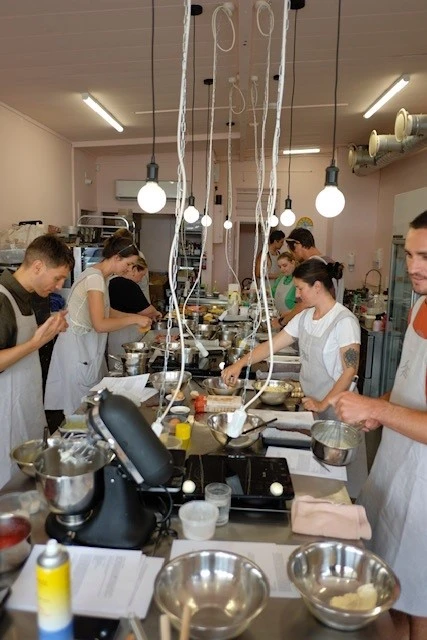
Photo courtesy of Maxine Scheckter, Sugar Flour
WCL: Then along came Covid – particularly hard for a young business reliant on doing things in person. How did you adapt?
MS: I was quite lucky. My mum had this idea of doing baking bags. So packing up stuff for classes, delivering it and then doing virtual classes. Because it was ingredients it was allowed. It was just me and it was no contact delivery. People enjoyed it and it managed to get me through Covid,. Without it Sugar Flour wouldn’t have survived. I was really lucky I guess.
WCL: Did taking the classes online help when you appeared on the television show Snack Masters in 2022?
MS: The first time I did the livestream class I was so incredibly nervous. By the end of it I was more used to it. I was quite nervous with Snack Masters but it was a really good crew. They were good at making us almost forget the cameras were there and making it really natural. Now I’m much less intimidated by that sort of thing than I used to be.
I participated in a singular episode. I had to recreate licorice allsorts and I was paired against Shaun from Logan Brown. He’d been my first employer. We had two and half days to figure out how to make a perfect licorice allsort.
When I lived in the UK I had watched the UK version and I was really excited to be part of the Kiwi version.
I love all of the Bake-offs. When I was a kid I’d turn on Food TV and it was always Bake-off. Those shows inspired me so much. To be part of that would be really cool.
WCL: You’ve since moved your pastry school to Newlands – why the move away from Kilbirnie?
MS: I originally opened in Kilbirnie then I moved to a shared kitchen in Miramar. I shared the kitchen with the Food Lab. I shared with them for a couple of years then it got to the point they were really busy and I was fully booked at weekends. We were both too big to share the kitchen, and it was their kitchen. I wanted to stay in that area but I couldn’t find a space that seemed to work. I’ve also had problems with landlords not wanting to lease to me because my business model is not traditional. Coming in as a younger woman, I found that if my Dad came with me to view a site they took me a lot more seriously than if I went by myself.
I started looking elsewhere because I realised there wasn’t space where I needed there to be a space. I looked at my customer figures and I realised a lot of my customers lived out Newlands/Johnsonville way. At that point I was living in Newlands and when a spot came up it worked out really well for me.
WCL: Now 2025 and the launch of your debut book Pâtisserie made simple : the art of petits gâteaux. I believe this is probably a first of its kind for Aotearoa?
MS: I’d like to say it is. I want to say it’s the first of its kind in general. I wanted it to be a mix between a professional pastry book and a home baking book, to bridge that gap. I feel like I have done that. I feel really proud of it.
Our ingredients are quite different here. Even something like flour is different here than it is in the UK or France. It was important to me that it made sense to people here who would be using it.
WCL: Did you pitch the idea to a publisher or were you approached by them?
MS: I pitched the idea. I kept seeing people release cook books and I would be really jealous. I was like “Why has no-one asked me to write a cookbook yet?” And I thought “Well maybe I should ask them” So I did.
I had one original pitch idea and some of the original recipes from that are in this book. I sent it to multiple publishers and Bateman was the one who picked it up.
It’s been over two years in the making.
WCL: The production values are gorgeous. How much artistic control did you have and how much was guided by the publisher?
MS: Normally authors, particularly first time authors, dont have a lot of say. You deliver the manuscript and all the photos and then they send you back some options.
I didn’t like that idea. I’m a bit of a control freak. A colleague of my husband has designed cookbooks so I commissioned him to do the cover design and some kind of layout. He basically did a template and I sent that off to the publisher so they knew what I wanted and I had more control.
The photographer, Amber-Jayne Bain, did the initial shoot for the proposal. They were so impressed with the photos we agreed she would do the whole book. She’s amazing, we had such a great time doing it. Saying she was the photographer is not enough. She was a stylist, she gave each pastry a full story and she really collaborated on it with me. My husband also came to every photoshoot. He’s very meticulous, and his job was to make sure every flower was facing the right way, all the gold leaf caught the light. It made a huge difference.
WCL: You write on your website that you “poured my heart, soul and quite a few tears into this book” Tell us about the process of writing. How did you go about it?
MS: Once I got the contract signed with the publishers I had a year to get them 100 recipes and 200 photos. So I started out by making a big list of 100 pastry ideas and then AJ, my husband, and I did a three day photoshoot once a month for that. We would shoot about ten pastries over the three days.
Every day for the last six months of that year I would write at least one recipe every evening. That was the hardest bit. Putting it on paper. About a month before it was due I got a bunch of friends to help proof read it and make changes. Then the next eight months was a lot of proof reading. It went to different editors that Bateman organised, and they would give me suggestions. I would either agree or disagree. Then I would get printed sheets in the mail with the layout of the book and go through and make physical changes to make sure the layout was right. There was a lot of back and forth and by the time the book came out I was really sick of reading it.
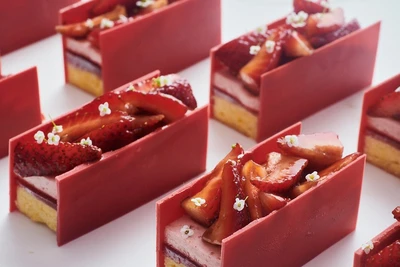
Photo courtesy of Maxine Scheckter, Sugar Flour
WCL: In the book you reimagine some New Zealand classics – afghans and lamingtons take on a whole new look when you make them – but you also introduce readers to some unusual ingredients and unique flavour combos.
Where do you get inspiration and how long does it take to perfect a flavour match? Black currant and violet, pandan and yuzu for example.
MS: I try and read a lot of cookbooks, learn a lot about different flavours from different cultures. Blackcurrant and violet was a flavour of a cake we would make at the place I worked in France. In France it’s quite a common flavour combination, but here it’s unheard of. I find the way flavours work fascinating.
Something like pandan is an Asian flavour. I see a lot of those things through Instagram. I’m seeing what flavours other cultures are using and trying to find ways to try it and pair it with things that balance it out well and make it taste good. I hope I’m not just taking from other people’s culture but trying to show there’s a whole world of flavour out there.
WCL: How do you go about sourcing some of these unique ingredients?
MS: A lot is word of mouth. That’s how I met [Yuzu grower] Neville Chun. Someone like that knows someone who knows someone who has this amazing product that is really hard to find. With the book I tried to keep it to things that were easily available or available with a bit of googling. You might not find it at a supermarket but if you go to your local Asian supermarket or farmers market, someone somewhere will have some.
WCL: You’ve achieved a lot in a relatively short career. What does the future hold?
MS: I don’t know. I said to my husband the other day “Have I peaked? Is this it?”
I guess I just want to keep finding things to do, to keep challenging myself. I remind myself quite often that I am very lucky to do what I do. I have a job where I go to work and get to play around and bake things. If it’s a disaster I can put it down to a learning experience. It sucks that it didn’t work but its part of my process. There’s a lot of things like this I couldn’t do if I worked for someone else. So just finding those opportunities, or trying to create those opportunities where I can.
I do miss living overseas but I love being in Wellington and close to family. I really like the life I have built here. I don’t know it I could achieve that overseas. Sometimes I look at the culinary scene somewhere like Melbourne and think “Oh, I could slot in there”. I think sometimes the grass seems greener but everywhere has its own problems and you just have to use what you’ve got.
WCL: Would you recommend becoming a pastry chef as a career to a younger person who enjoys baking?
MS: That’s a tricky one. I do but … you have to really love it. If you just enjoy it and like it as a hobby its not going to be that good as a job. The pay isn’t great, the hours aren’t great. There’s a lot of stuff that isn’t rewarding in the slightest, so if you don’t love it you aren’t going to get enough out of it.
But if you love it, it’s so incredibly rewarding and it’s special to be part of making memories for people.

- Pâtisserie made simple : the art of petits gâteaux by Maxine Scheckter, 2025